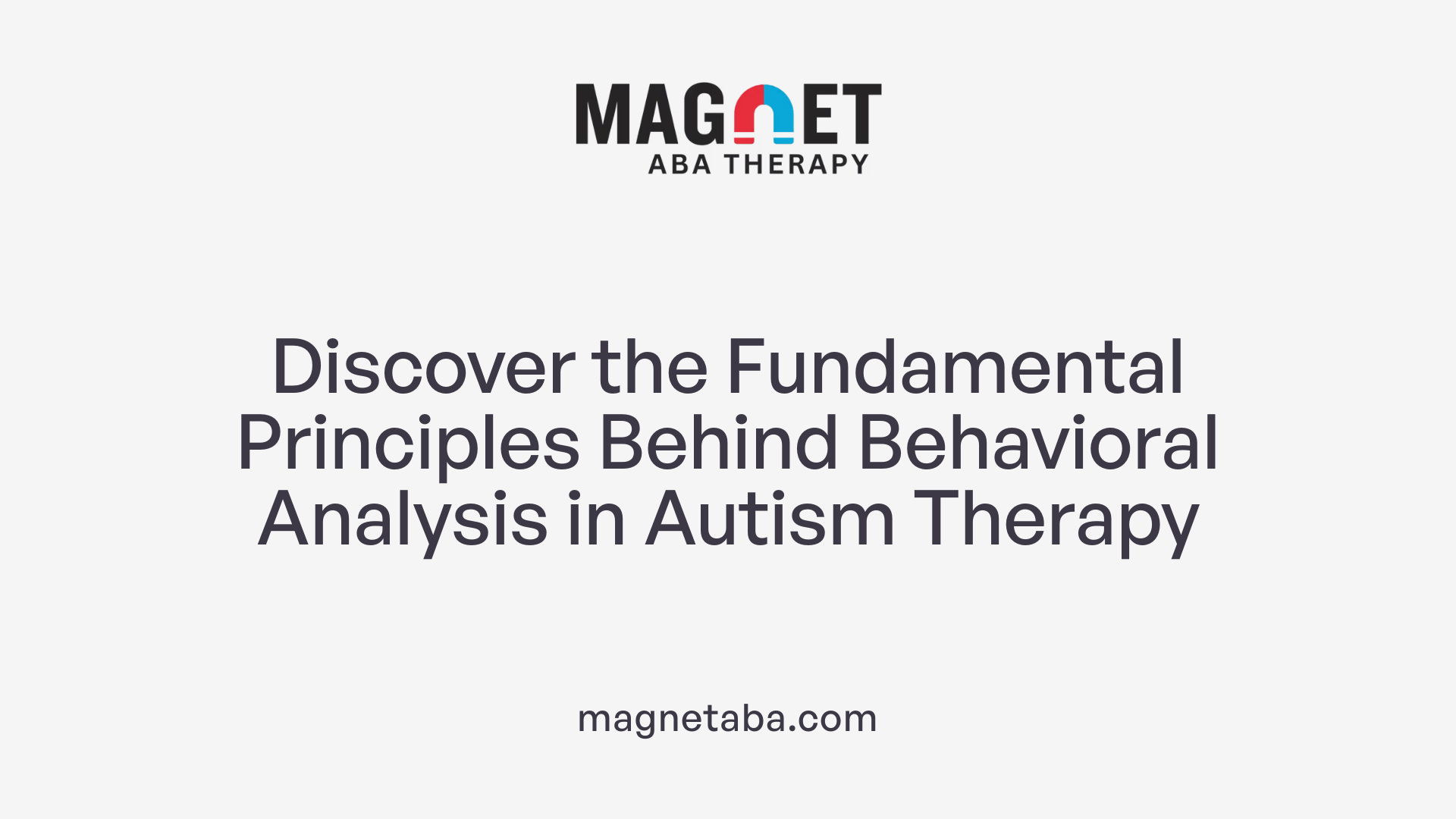Understanding ABA Therapy and Its Role in Autism
Applied Behavior Analysis (ABA) therapy is a well-established, science-based approach designed to improve social, communication, and behavioral skills in children with autism spectrum disorder (ASD). By employing reinforcement and structured interventions, ABA specifically helps children develop greater attention and focus, key aspects that influence academic success and daily functioning. This article explores the core principles of ABA, its implementation, benefits, challenges, and its impact on attention and focus among children with autism.
What is Applied Behavior Analysis (ABA) Therapy?
Definition and Science Behind ABA
Applied Behavior Analysis (ABA) therapy is a systematic, evidence-based approach grounded in the science of behaviorism. It focuses on understanding and changing behavior through learning principles, primarily operant conditioning, which involves reinforcing positive behaviors and reducing negative ones. ABA programs are personalized, often incorporating structured interventions like positive reinforcement, modeling, and discrete trial training to help individuals learn new skills and improve existing ones.
Usage in Autism Treatment
ABA therapy is widely used to support children with Autism Spectrum Disorder (ASD) and other developmental disabilities. It aims to improve socially significant behaviors such as communication, social interactions, and daily living skills through targeted teaching strategies. Research demonstrates that ABA can enhance language development, attention, emotional regulation, and adaptive functioning in autistic children. Additionally, ABA techniques have been adapted for use in other conditions like ADHD and OCD.
Individualized Therapy Approach
One of the central components of ABA is its individualized design based on each child's unique strengths and needs. Therapists conduct thorough assessments and develop tailored intervention plans. Children who benefit most often enjoy predictability, structure, and repetition. Effective programs may involve high-intensity sessions with 20 to 40 hours weekly, adjusted as children progress. Parents and caregivers play a vital role by actively participating and monitoring therapy's safety and outcomes.
Therapy Goals and Methods
The core goals of ABA include increasing positive and functional behaviors while reducing harmful or disruptive ones. Therapy also focuses on skill building—like requesting desired items, safely crossing streets, or organizing personal belongings. Methods used include reinforcement strategies, discrete trial training, and natural environment teaching. Emphasizing meaningful, strengths-based, and safe practices ensures therapy supports the child's overall well-being and independence.
| Aspect | Description | Example/Application |
|---|---|---|
| Science Basis | Behaviorism and operant conditioning | Reinforcing a child for communication attempts |
| Target Population | Children with ASD and developmental disabilities | Early Intensive Behavioral Interventions (EIBI) |
| Individualization | Tailored to child’s unique needs and strengths | Customized skill acquisition plans |
| Core Methods | Positive reinforcement, discrete trials, modeling | Teaching crossing the road safely using prompts |
| Therapy Goals | Improve communication, social skills, reduce problem behavior | Enhancing daily living skills and emotional regulation |
Core Principles of Behavioral Analysis in Autism Therapy

What are the core principles behind behavioral analysis in autism therapy?
Applied Behavior Analysis (ABA) in autism therapy is firmly rooted in behaviorism, a scientific theory of learning that explores how behaviors are influenced by their environment. At the heart of ABA lies the understanding that behavior is shaped by consequences, making reinforcement a fundamental strategy. Positive reinforcement—rewarding desirable behavior—increases the likelihood that this behavior will recur.
A crucial tool in ABA is the ABC model, standing for Antecedent, Behavior, and Consequence. This model helps therapists analyze what triggers a behavior and what follows it, facilitating targeted intervention strategies. Functional Behavior Assessment (FBA) further refines this by identifying the specific function or purpose behind behaviors, allowing for customized treatment plans that address the root causes rather than just symptoms.
ABA prioritizes a data-driven approach, where ongoing measurement of behavior guides decision-making. Therapists collect detailed data on behaviors to track progress and tweak interventions in real-time. This ensures that therapy is both effective and responsive to individual needs. Techniques such as prompting (giving cues), shaping (reinforcing gradual steps toward a behavior), extinction (reducing unwanted behaviors by removing reinforcement), and behavior chaining (linking simple behaviors into complex sequences) are employed.
Individualization is another cornerstone of ABA therapy. Programs are designed around each child's unique strengths and challenges, with clear, structured, and repetitive steps that match the child’s learning style. This tailored approach supports skill development in areas like communication, social interaction, and daily living, while also addressing behaviors that might be harmful or disruptive.
In summary, ABA’s core principles combine behaviorist theory with structured reinforcement, thorough behavior assessment, continuous data monitoring, and personalization. These elements work together to promote positive behavior change and skill acquisition in autistic children, grounded in scientifically validated methods.
Who Provides ABA Therapy for Autism?
Professional qualifications and certifications
ABA therapy for individuals with autism is typically delivered by professionals who have completed specialized training and certification. One of the central credentials is the Board-Certified Behavior Analyst (BCBA), a designation for experts in behavior analysis who design and oversee individualized therapy programs. Behavior therapists and other trained providers also implement the therapy under BCBA supervision. Although there is no nationally mandated regulatory body in every region, voluntary certification organizations such as ABA Australia establish ethical standards and best practices to assure quality care.
Roles of Board-Certified Behavior Analysts and therapists
BCBAs primarily conduct assessments, develop tailored intervention plans, and monitor treatment progress. Behavior therapists work directly with children to implement specific ABA techniques including positive reinforcement, discrete trials, and natural environment training. Parents and caregivers are encouraged to engage actively in therapy to provide consistent reinforcement and ensure that interventions align with the child's needs and family goals.
Settings for ABA therapy delivery
ABA therapy may be provided in a variety of settings suited to the child's lifestyle and treatment goals. Common venues include the child's home to promote learning in a familiar environment, outpatient clinics for structured sessions, schools for integrating social and communication skills, and community locations to practice real-world behaviors. This flexibility helps maximize therapy effectiveness while accommodating individual preferences and schedules.
Insurance and regional considerations for accessibility
The availability and cost of ABA therapy are influenced by insurance coverage and regional policies. Treatment costs can average around $120 per hour, but many families benefit from insurance plans that cover ABA services, depending on state requirements and health policies. Coverage may include private insurance, Medicaid, or specialized programs like Tricare and VA waivers. Because insurance mandates vary by location, accessing affordable ABA therapy requires navigating jurisdiction-specific resources and provider networks.
How ABA Therapy Enhances Attention and Focus in Children with Autism
ABA Techniques Improving Concentration
Applied Behavior Analysis (ABA) therapy uses specific techniques designed to bolster concentration in children with autism spectrum disorder (ASD). Methods such as discrete trial training and natural environment training create structured learning opportunities that promote sustained attention. Through repetition and clear task steps, children gradually build their ability to focus on individual activities.
Positive Reinforcement's Role in Attention
Positive reinforcement is central to ABA and plays a significant role in enhancing attention. By rewarding desirable behaviors, including sustained focus during tasks, ABA encourages children to repeat these behaviors. This reinforcement approach helps increase motivation to engage and persist with learning activities.
Improved Emotional Regulation Fostering Focus
ABA therapy also supports emotional regulation skills, which are closely linked to concentration. Techniques that reduce anxiety or frustration enable children to better manage their feelings, leading to improved attentiveness and reduced behavioral disruptions. When children regulate emotions effectively, maintaining focus on tasks becomes easier.
Research Supporting Attention Benefits
Research underscores that ABA therapy can improve attention and focus in children with ASD, positively influencing their learning and school success. Studies demonstrate that these benefits contribute to enhanced social interactions and daily skill development. Although the extent of improvement may vary, consistent ABA interventions have shown medium effect sizes on intellectual functioning and adaptive behaviors, indicating meaningful progress in attention-related skills.
Key ABA Techniques to Promote Attention and Learning
What are Positive Reinforcement and How Does It Work?
Positive reinforcement is a fundamental ABA technique that encourages desirable behaviors by offering rewards or praise immediately after the behavior occurs. For children with Autism Spectrum Disorder (ASD), this method helps increase attention and motivation, supporting skill development and behavior improvement.
What is Discrete Trial Training?
Discrete Trial Training (DTT) breaks down complex skills into small, manageable steps. Each step is taught systematically using prompts and reinforcements. DTT provides structure and repetition, ideal for children who thrive on predictability. It helps improve attention by focusing on one skill at a time in a controlled setting.
How Does Modeling Behaviors Influence Learning?
Modeling involves demonstrating the desired behavior for the child to imitate. This method allows children to observe and learn appropriate behaviors and social skills in real time. Modeling can enhance attention and learning by providing clear examples of what is expected.
What is Natural Environment Training?
Natural Environment Training (NET) teaches skills within everyday settings rather than isolated therapy rooms. By embedding learning opportunities into routine activities like play or mealtime, NET promotes generalization of skills and sustained attention in real-world situations.
These ABA techniques—Positive Reinforcement, Discrete Trial Training, Modeling, and Natural Environment Training—work together to improve focus, communication, and social skills in children with ASD. They create structured yet meaningful learning experiences that support attention and developmental success.
The Importance of Early and Intensive ABA Intervention
Benefits of Starting ABA in Early Childhood
Early intervention with ABA therapy is crucial for children with Autism Spectrum Disorder (ASD). Research highlights that beginning treatment in early childhood can significantly maximize developmental outcomes. This is primarily because the younger brain exhibits higher plasticity, allowing children to acquire essential social, communication, and daily living skills more effectively.
Effect of Treatment Intensity and Duration
The intensity and duration of ABA therapy play vital roles in the therapy’s success. High-intensity programs, often involving 20 to 40 hours of therapy per week, are linked to greater improvements in intellectual functioning and adaptive behavior. Longer and sustained treatment periods contribute to better progress, underscoring that therapy should be consistent and extended over time to achieve optimal results.
Individualized, Multi-Skill Targeting Approaches
Applied Behavior Analysis is most effective when customized to meet each child’s specific needs. Individualized programs focus on multiple skill areas such as communication, social interaction, emotional regulation, and practical daily tasks. This multi-skill targeting approach ensures the intervention is comprehensive, addressing the child’s unique strengths and challenges rather than using a generic, one-size-fits-all strategy.
Link to Developmental Outcomes
Evidence from meta-analyses involving hundreds of children internationally confirms that early and intensive ABA interventions foster improvements in intellectual functioning and adaptive behaviors. These developmental gains include enhanced attention, better emotional regulation, and improved social skills, which are critical for successful integration in educational settings and daily life activities.
By prioritizing early, intense, and tailored ABA therapy, caregivers and clinicians can substantially enhance the developmental trajectory of children with autism, helping them build foundational skills that support long-term growth and success.
The Role of Structure, Predictability, and Repetition in ABA
Why is ABA suitable for children who prefer routine and predictability?
ABA therapy is highly structured and emphasizes clear, consistent steps, making it particularly effective for children who thrive in predictable environments. This structure provides a stable framework that can reduce anxiety and help children feel comfortable as they learn new skills. With routine and repetition, children are able to anticipate what comes next, which supports smoother learning processes.
How are clear steps used in ABA to facilitate skill development?
The approach breaks down complex skills into small, manageable steps that children can master one at a time. This step-by-step method enables gradual learning and reinforces each correct behavior before moving on. By providing clear expectations, ABA helps children with developmental disabilities build skills such as communication, safety practices, and daily living tasks in a systematic way.
How do reinforcement patterns in ABA support improved focus and attention?
One of the cornerstones of ABA is positive reinforcement, which rewards desired behaviors to encourage repetition. By using consistent rewards, ABA helps strengthen the child's concentration on specific tasks. This focused attention can profoundly impact their ability to learn and generalize skills across settings.
In what ways does structured ABA therapy enhance attentional control?
The predictable, routine nature of ABA sessions trains children to engage with activities in a controlled, focused manner. This repeated practice helps improve their emotional regulation and concentration over time. Increased attentional control gained through ABA can translate into better success in school and daily activities where sustained focus is essential.
ABA Therapy Impact on Daily Living Skills and Functional Communication

How does ABA teach practical daily living skills?
Applied Behaviour Analysis (ABA) therapy helps children learn essential skills needed for everyday tasks that promote independence. For instance, ABA techniques can teach children how to cross streets safely by breaking down the process into clear, manageable steps using repetition and reinforcement. This structured approach builds confidence and ensures safety in real-life settings.
In what ways does ABA support communication development?
ABA encourages communication skills vital for expressing needs and desires, such as asking for something they want. Therapists use systems like the Picture Exchange Communication System and targeted reinforcement strategies to improve children’s ability to request items or assistance. These methods enhance functional communication, reducing frustration and supporting social interaction.
How does ABA improve focus and support independent living?
Children benefiting most from ABA typically thrive in environments with predictability, structure, and repetition. Through consistent practice and positive reinforcement, ABA increases attention span and emotional regulation, which are critical for learning complex daily living skills. Improved focus helps children participate meaningfully in household routines and community activities.
How does ABA foster meaningful participation in daily life?
By emphasizing strengths and tailoring interventions to individual needs, ABA therapy makes learning functional skills engaging and relevant. Skills taught through ABA—such as packing a school bag or managing self-care tasks—enable children to take active roles in their daily lives. This not only boosts independence but also supports their overall quality of life.
| Aspect | Description | Examples |
|---|---|---|
| Practical Skill Training | Breaking down tasks into steps with reinforcement | Crossing the road safely |
| Communication Development | Enhancing ability to request needs using systematic approaches | Picture Exchange Communication System |
| Focus and Emotional Regulation | Structured repetition improving attention and behavior | Improved school participation |
| Meaningful Participation | Tailored, strengths-focused interventions promoting independence | Packing school bags, daily routines |
Addressing Challenging Behaviors to Improve Attention
Managing Harmful or Disruptive Behaviors
Applied Behaviour Analysis (ABA) therapy is often used to address concerning behaviors in children with autism spectrum disorder (ASD) or developmental disabilities, such as self-harm, aggression towards others, or property destruction. These behaviors can interfere significantly with a child's safety and learning opportunities. ABA therapists employ behavior modification strategies grounded in reinforcement techniques to reduce these harmful or disruptive behaviors while promoting positive alternatives.
Reducing Behaviors That Interfere with Focus
One important goal of ABA therapy is enhancing a child's attention and focus, which are essential for developing social, communication, and daily living skills. Through repeated, structured interventions, ABA uses reinforcement to encourage behaviors that improve concentration and emotional regulation. Enhanced attention achieved via ABA techniques like positive reinforcement and discrete trial training can support academic success and social engagement for children with ASD.
Behavior Modification Strategies
ABA utilizes several behavior modification methods, including:
- Positive Reinforcement: Rewarding desirable behaviors to increase their frequency.
- Discrete Trial Training (DTT): Teaching skills in small, structured steps with immediate feedback.
- Modeling: Demonstrating behaviors for the child to imitate.
- Natural Environment Training (NET): Promoting skills in everyday contexts to encourage generalization. These strategies are systematically applied to increase helpful behaviors while decreasing problematic ones.
Safe Versus Unsafe ABA Practices
Safe ABA practices prioritize individualized, meaningful, and strengths-focused interventions. These approaches avoid punishment, negative consequences, or efforts to enforce neurotypical behavior or claim to "cure" autism. Caregivers are encouraged to actively participate in therapy, ensuring it aligns with ethical standards and best practices. Conversely, unsafe ABA methods involve punitive or generalized tactics that can harm the child's well-being and are inconsistent with contemporary professional guidelines.
| Aspect | Safe ABA Practices | Unsafe ABA Practices |
|---|---|---|
| Approach | Individualized, strengths-based, meaningful | Punishment-based, negative, neurotypical conformity |
| Caregiver Role | Active participation and monitoring | Excluded or minimized involvement |
| Focus | Enhancing skills and positive behaviors | Curing autism or enforcing typical behavior patterns |
| Reinforcement | Positive reinforcement and rewards | Punishment and negative reinforcement |
By focusing on safe, evidence-based ABA practices, therapy can effectively support children in managing challenging behaviors and improving attention, fostering their development and quality of life.
Long-Term Benefits of ABA on Intellectual Functioning and Adaptive Behavior
What Do Meta-Analyses Reveal About ABA Interventions?
Several meta-analyses provide a comprehensive assessment of Applied Behavior Analysis (ABA) therapy outcomes in children with Autism Spectrum Disorder (ASD). One meta-analysis pooling data from 11 studies, involving 632 participants, found that ABA-based interventions resulted in medium effect sizes, with a standardized mean difference (SMD) of 0.51 for intellectual functioning and 0.37 for adaptive behavior improvements. These findings support ABA's value as an evidence-based therapy for children with developmental disabilities.
How Does ABA Impact Intellectual Skills and Adaptation?
ABA therapy emphasizes systematic reinforcement to improve behavior and facilitate new skill acquisition. Research shows that such structured interventions enhance intellectual functioning — the cognitive abilities essential for learning and reasoning. Additionally, adaptive behavior, which includes practical daily living skills, also benefits significantly.
Improvements in adaptive behavior translate to better social communication, self-care, and independence, which are pivotal for children’s quality of life. These changes positively affect their ability to function in real-world environments.
Does the Length and Individualization of Therapy Affect Outcomes?
Research underscores that longer, more intensive ABA treatments lead to greater developmental gains. Treatments often involve 20 to 40 hours of therapy weekly, targeting multiple skill areas with individualized plans tailored to each child's needs and baseline abilities.
Extended therapy duration allows consistent reinforcement and practice, which promotes skill acquisition and generalization. Personalized interventions that address individual strengths and challenges further maximize progress. Early intervention plays a critical role in leveraging neuroplasticity for improved outcomes.
Are These Findings Applicable Globally?
Studies including diverse international cohorts — such as a notable sample of approximately 500 children worldwide — affirm the broad applicability of ABA therapy. The consistency of positive results across different cultural and clinical contexts suggests ABA is adaptable and effective internationally.
This global evidence highlights the need for policymakers and clinicians worldwide to prioritize accessible and individualized ABA interventions to optimize developmental outcomes in children with ASD.
Limitations and Challenges of ABA Therapy
Variability in Individual Response
Applied Behavior Analysis (ABA) therapy, while effective for many children with autism spectrum disorder (ASD), does not guarantee uniform success for all. Children differ in how they respond to treatment due to factors such as baseline intellectual abilities, age at intervention start, and the specific nature of their ASD symptoms. This variability means some children may make significant gains in communication and adaptive behaviors, while others may experience more limited improvements.
Demanding Therapy Intensity
ABA programs often require high-intensity intervention, frequently ranging from 20 to 40 hours per week. This demanding schedule can place a considerable strain on children and their families. The time commitment raises concerns about therapy fatigue or burnout, and may not be sustainable for all families, limiting its accessibility or consistent application.
Criticism of Over-Standardization
Critics of ABA sometimes point to the potential for therapies to focus excessively on conformity and compliance to neurotypical norms. Such over-standardization can risk overlooking individual differences, strengths, and preferences. This approach may cause discomfort or dissatisfaction when a child’s unique personality and natural responses are undervalued during treatment.
Methodological Limitations in Research
Research on ABA's effectiveness has demonstrated promising improvements in intellectual functioning and adaptive behavior but is not without its limitations. Studies often suffer from low-quality evidence, risks of bias, and wide variability in control conditions. Furthermore, some meta-analyses indicate no significant improvements in language abilities or reductions in parental stress, suggesting that benefits might not be uniform across all developmental areas. These methodological issues highlight the need for more rigorous, large-scale studies to better understand and optimize ABA therapy.
ABA therapy represents a powerful, evidence-based approach to supporting children with ASD. However, it remains important to consider its challenges—such as individual differences in response, intensive time requirements, concerns regarding standardization, and research limitations—to ensure treatment is both effective and respectful of each child’s unique needs.
The Crucial Role of Parental and Caregiver Involvement in ABA
Why is active participation in therapy vital?
Parents and caregivers play a fundamental role in the success of ABA therapy. Active participation means engaging with therapists during sessions, reinforcing strategies at home, and learning how to apply ABA principles in everyday situations. This involvement helps ensure consistency in the child's learning environment, which can accelerate skill acquisition and behavioral improvements.
How can parents monitor the safety and effectiveness of ABA?
Caregivers are encouraged to observe and evaluate therapy regularly to ensure it is safe and beneficial. Safe ABA practices are individualized, meaningful, strengths-focused, balanced, and avoid punitive or negative methods. Monitoring involves watching for positive changes in behavior and skills, noting any adverse effects, and communicating concerns with therapy providers promptly.
How does aligning therapy with best practices benefit the child?
Ensuring that ABA therapy aligns with recognized best practices helps prevent harmful interventions and supports the child's unique needs. Best practices emphasize reinforcement of positive behavior rather than punishment and discourage any attempts to change autistic traits to conform to neurotypical norms. This ethical alignment promotes dignity and respect for the child’s individuality.
What is the importance of meaningful family engagement?
Meaningful family engagement extends beyond therapy sessions to the family’s overall involvement in the child's development. It involves education about ABA principles, collaboration with therapists in goal setting, and support that respects the child’s strengths and challenges. Families who are engaged contribute significantly to maintaining progress and generalizing learned behaviors to real-life contexts.
By embracing these roles, parents and caregivers not only enhance the effectiveness of ABA therapy but also ensure it remains a supportive, respectful, and empowering process for their child.
Distinguishing Safe vs. Unsafe ABA Practices

What Are the Characteristics of Safe ABA?
Safe ABA practices are individualized, focusing on the unique strengths and needs of each child. Therapy is designed to be meaningful and helpful, ensuring interventions are balanced and supportive rather than overly rigid. This approach prioritizes creating a safe environment where positive behaviors are reinforced, and children feel respected and understood throughout their learning process.
What Are the Risks of Punitive or Negative Methods?
Unsafe ABA methods often involve punishment or negative reinforcement strategies, which can harm a child's emotional well-being. Such practices might suppress unwanted behaviors temporarily but do not teach alternatives, potentially leading to increased frustration or distress. Punitive tactics can create fear or anxiety, reducing the effectiveness of therapy and damaging the trust between child and therapist.
Why Are Therapies That Promote Neurotypical Behavior Problematic?
Therapies aiming to normalize autistic children by pushing neurotypical behavior risk invalidating and stigmatizing their natural ways of interacting with the world. These approaches ignore the importance of respecting neurodiversity and can cause psychological harm, undermining a child’s self-esteem and identity. It is crucial to avoid therapies that claim to "cure" autism or forcibly change fundamental traits.
How Can Ethical ABA Therapy Be Ensured?
Parents and caregivers should actively participate in the therapy process, monitor the intervention's safety and effectiveness, and collaborate with professionals committed to best-practice standards. Ethical ABA should be transparent, evidence-based, and adaptable to the child's evolving needs. Organizations like ABA Australia offer voluntary certification and ethical guidelines that practitioners can follow to maintain high standards of care.
| Aspect | Safe ABA | Unsafe ABA | Description |
|---|---|---|---|
| Approach | Individualized and strengths-focused | Punitive and generalized | Safe ABA tailors support; unsafe ABA uses broad negative tactics |
| Emotional Impact | Respectful and supportive | Fear-inducing and stressful | Safe ABA fosters trust; unsafe ABA causes distress |
| Therapy Goals | Meaningful, skill-building | Forcing neurotypical behavior | Safe ABA honors identity; unsafe ABA stigmatizes autism |
| Caregiver Involvement | Active and collaborative | Limited or absent | Parental engagement ensures ethical standards |
ABA Therapy Beyond Autism: Applications for Other Conditions
How is ABA used to treat conditions other than autism?
ABA therapy, rooted in behaviorism and operant conditioning, is versatile and applied beyond autism spectrum disorder (ASD). It serves as a treatment option for conditions such as Attention Deficit Hyperactivity Disorder (ADHD), Obsessive-Compulsive Disorder (OCD), and Post-Traumatic Stress Disorder (PTSD). In these situations, ABA principles help manage and reshape problematic behaviors by reinforcing desirable behaviors similar to its approach with ASD.
What about behavioral issues related to brain injuries?
ABA also addresses behavioral challenges following traumatic brain injuries (TBI). Through individualized, structured interventions, it aids individuals in relearning skills and managing behaviors such as aggression or difficulty following directions. Therapy focuses on breaking down complex tasks into manageable steps, encouraging positive behavior through reinforcement strategies.
Are there common principles across these disorders?
Yes, regardless of the condition, ABA therapy emphasizes increasing positive behaviors and reducing problematic ones using systematic reinforcement. Techniques like positive reinforcement, discrete trial training, and natural environment training remain fundamental. The flexibility to tailor interventions to each person's unique needs and strengths is a core aspect, ensuring meaningful and effective support.
How flexible are ABA methods in different applications?
ABA’s methods are highly adaptable. Whether teaching communication in autism or reducing compulsive behaviors in OCD, the therapy is customized to the individual’s goals and contexts. For example, the pace, intensity, and specific skills targeted can differ widely while maintaining ABA’s foundational strategies. This flexibility makes ABA a powerful tool across a variety of developmental and behavioral conditions.
| Condition | ABA Application | Key Focus of Therapy |
|---|---|---|
| Autism Spectrum Disorder | Skill acquisition, behavior modification | Enhancing communication and social skills |
| ADHD | Improving focus and self-regulation | Managing attention and reducing impulsivity |
| OCD | Reducing compulsive behaviors | Behavior modification through exposure-based techniques |
| PTSD | Managing anxiety and behavioral responses | Reinforcing coping behaviors |
| Traumatic Brain Injury | Relearning tasks, controlling behaviors | Behavioral management and skill reacquisition |
ABA's evidence-based, structured, and individualized framework allows it to transcend diagnoses, making it an effective therapy option across diverse behavioral and developmental challenges.
Cost and Accessibility Challenges in ABA Therapy
Average Costs and Factors Influencing Price
ABA therapy can be costly, with rates around $120 per hour on average. However, the overall expense depends on several factors including the severity of the child's condition, the type of ABA program chosen, qualifications of the provider, and how many therapy hours are required. Intensive programs involving 20-40 hours weekly naturally increase total costs.
Variability in Insurance Coverage
Insurance coverage for ABA therapy is inconsistent and depends heavily on the state or region. Some states mandate that insurers cover ABA services for children with autism, which can significantly reduce out-of-pocket expenses for families. However, in areas without such mandates, families may face substantial financial burdens.
Regional Differences in Availability
Accessibility to ABA therapy varies across regions. In Australia, for example, there are no regulatory bodies overseeing ABA, though professional organizations provide certification and ethical guidelines voluntarily. Availability may be limited based on local provider qualifications and the presence of specialized programs.
Financial Support Options for Families
Families seeking ABA therapy may explore various financial support options such as insurance plans that include ABA benefits, government assistance programs, and community resources. Active participation by caregivers in therapy can also help ensure treatments remain effective, safe, and aligned with best practices, potentially maximizing the value of investment in therapy.
| Aspect | Details | Impact on Families |
|---|---|---|
| Cost per Hour | Approximately $120 | Can be expensive without insurance |
| Therapy Intensity | 20-40 hours/week for comprehensive programs | Higher cost but often yields better results |
| Insurance Coverage | Varies by state/region | Coverage reduces costs; lack increases burdens |
| Regulatory Oversight | Voluntary certification (e.g., ABA Australia) | May affect quality and availability |
| Financial Assistance | Government, insurance, community resources | Provides critical support to offset costs |
ABA Therapy Programs Based on Behavioral Principles

What are the main ABA-based therapy programs?
Several structured programs use Applied Behavior Analysis (ABA) principles to support autistic children by enhancing social, communication, and daily living skills.
Early Intensive Behavior Intervention (EIBI): This is a commonly used ABA-based program focusing on high-intensity therapy sessions, often 20-40 hours per week. It targets multiple skills through personalized interventions starting in early childhood. EIBI emphasizes systematic reinforcement and is designed to boost intellectual functioning and adaptive behavior.
Picture Exchange Communication System (PECS): PECS helps children develop communication skills by teaching them to use pictures to express needs and desires. This approach aligns with ABA’s reinforcement strategies, enabling children to learn functional communication in a structured way.
Early Start Denver Model (ESDM): Integrating ABA with developmental and relationship-based approaches, ESDM targets social, cognitive, and language skills. It is suitable for young children and involves naturalistic teaching techniques combined with behavioral reinforcement.
Verbal Behavior Approach: This ABA-based program focuses specifically on language and communication development by teaching children the functional uses of words and phrases. It applies operant conditioning principles to teach requesting, labeling, and conversational skills.
How do these programs use ABA principles?
Each of these interventions relies on behaviorism fundamentals like reinforcement to increase positive behaviors, skill acquisition, and communication abilities. They provide structured, individualized learning opportunities with clear steps, benefiting children who thrive with predictability and repetition.
By combining intensive, personalized therapy with positive reinforcement, ABA programs promote meaningful skill development in communication, social interaction, and everyday functioning, which research has shown to improve outcomes for many children with autism spectrum disorder.
Measuring ABA Therapy Outcomes: Attention, Communication, and Social Skills
What Evaluation Metrics Are Used in ABA Research?
ABA therapy outcomes are typically measured through improvements in attention, communication, social skills, intellectual functioning, and adaptive behavior. Researchers use standardized metrics such as the standardized mean difference (SMD) to quantify gains in intellectual and adaptive skills among children with Autism Spectrum Disorder (ASD). Comprehensive ABA-based interventions are often evaluated on multiple fronts including behavior changes, language acquisition, and daily living skills.
What Data Supports Improvements in Attention?
One notable benefit of ABA therapy is the enhancement of children's attention and focus. Improved attention supports better development and contributes to success in academic and social settings. ABA techniques, including positive reinforcement and structured learning, help children with ASD improve emotional regulation and concentration. These improvements in attention are critical as they influence a child's overall learning capacity and engagement during therapy.
How Does ABA Impact Language and Social Skills?
ABA-based therapies are designed to improve language development and social skills in children with autism. Research shows significant improvements in social interactions and communication abilities following ABA interventions. Therapy programs such as the Early Intensive Behavioral Intervention (EIBI) and Verbal Behavior approach, which involve high treatment intensity, have demonstrated effectiveness in fostering these skills. Enhanced communication abilities include asking for needs and engaging socially, which are fundamental for everyday functioning.
What Are the Limitations in Language Progress Findings?
Despite evidence showing progress in intellectual and adaptive behavior, studies reveal no significant improvements specifically in language abilities attributable to ABA. Meta-analyses highlight that language gains after ABA therapy may be inconsistent or limited, potentially due to methodological challenges such as study quality, bias risks, and small sample sizes. Furthermore, factors like baseline language skills, treatment intensity, age, and parental involvement might influence outcomes, but current data is insufficient to confirm definitive effects.
| Outcome Area | Findings | Notes |
|---|---|---|
| Attention and Focus | Improved | Enhances engagement and emotional regulation |
| Social and Communication | Significant gains | Includes verbal requests and social interaction |
| Intellectual Functioning | Medium effects (SMD=0.51) | Evident in comprehensive ABA interventions |
| Adaptive Behavior | Medium effects (SMD=0.37) | Improvements in daily living skills |
| Language Abilities | No significant improvements detected | Limited by methodological issues and participant variability |
ABA therapy demonstrates meaningful outcomes in attention, social skills, and intellectual functioning, while highlighting a need for further research to clarify its impact on language development.
The Science of Operant Conditioning in ABA and Focus Development

What is the operant conditioning basis of ABA?
Applied Behavior Analysis (ABA) is fundamentally grounded in operant conditioning, a learning theory developed within behaviourism. This theory emphasizes that behaviours can be shaped and modified through consequences — specifically reinforcement and punishment. In ABA, systematic reinforcement is used to encourage positive behaviours by providing rewards or desirable outcomes when the behaviour occurs. This process helps children learn new skills or adopt beneficial habits by associating certain actions with positive feedback.
How does systematic reinforcement shape behaviour?
Systematic reinforcement in ABA involves consistent and planned rewards that increase the likelihood of a desired behaviour recurring. Techniques such as positive reinforcement, discrete trial training, and modelling are used to break complex skills into manageable steps, rewarding the child after each successful step. This encourages repetition and mastery. For example, a child may receive praise, tokens, or preferred items after demonstrating a targeted skill, reinforcing their motivation to continue that behaviour.
How is operant conditioning related to improvements in attention?
ABA therapy is well-known for enhancing attention and focus among children with Autism Spectrum Disorder (ASD). Through operant conditioning techniques, children learn to sustain attention by receiving immediate and meaningful reinforcement when they demonstrate focused behaviours. Over time, this helps improve their concentration, which positively influences their learning outcomes and success in environments like school.
What role does operant conditioning play in emotion regulation?
Operant conditioning also supports better emotional regulation in children undergoing ABA therapy. By reinforcing desirable emotional responses and coping behaviours, ABA helps children develop greater control over their emotions. For instance, when a child learns alternative ways to express frustration and is rewarded for these behaviours, it reduces instances of negative actions like self-harm. This structured reinforcement promotes healthier emotional reactions and overall well-being.
| Aspect | Description | Impact on Therapy Outcomes |
|---|---|---|
| Operant Conditioning | Learning theory using consequences to shape behaviour | Foundation for behaviour change in ABA |
| Systematic Reinforcement | Planned rewards for desired behaviour | Increases skill acquisition and positive behaviour frequency |
| Attention Improvement | Reinforcement of focused behaviours | Enhances concentration and school success |
| Emotion Regulation | Reinforcing adaptive emotional responses | Reduces problematic behaviours and promotes well-being |
Global Evidence Supporting ABA’s Effectiveness
What international research supports the effectiveness of ABA therapy?
Multiple international studies have examined the impact of ABA therapy on children with Autism Spectrum Disorder (ASD). These investigations highlight significant improvements in social interactions, communication abilities, intellectual functioning, and adaptive behavior among participants who received ABA-based interventions. For example, a meta-analysis including 11 studies with 632 participants found that comprehensive ABA interventions had moderate positive effects on intellectual functioning (standardized mean difference SMD=0.51) and adaptive behavior (SMD=0.37).
What sample sizes and meta-analysis outcomes demonstrate ABA's impact?
Large sample sizes in these meta-analyses, such as approximately 500 children cited in diverse global studies, provide robust evidence for ABA’s efficacy. The consistent findings across multiple countries demonstrate the therapy’s applicability worldwide. Although language abilities and symptom severity did not always show significant improvement, gains in cognitive and adaptive skills were repeatedly observed. This suggests that ABA effectively targets practical developmental skills critical for daily functioning.
What are the implications of this global research for autism treatment protocols?
These global findings emphasize the value of integrating ABA-based treatments into autism care protocols internationally. Given the evidence for improved intellectual and adaptive functioning, ABA represents a crucial component of early and intensive intervention programs. Tailoring programs to individual needs and maintaining high treatment intensity (20–40 hours per week) are associated with greater progress, underscoring personalized therapy plans.
Why is policy support important to facilitate ABA therapy availability worldwide?
The research also highlights the need for policymakers and clinicians to ensure ABA therapy is accessible to children with ASD. Making evidence-based ABA interventions widely available can maximize developmental outcomes globally. However, access depends on regulatory frameworks, insurance coverage, and funding availability, which remain inconsistent in many regions. Advocating for policy support can expand access, reduce disparities in care, and improve quality of life for children and families affected by autism.
| Aspect | Details | Notes |
|---|---|---|
| International Studies | Multiple countries, large samples (~500 children) | Demonstrates ABA’s global applicability |
| Meta-Analysis Outcomes | Improved intellectual functioning (SMD=0.51) & adaptive behavior (SMD=0.37) | Moderate effects confirm consistent benefits |
| Implications for Protocols | Supports early, intensive, and individualized interventions | Tailored therapy plans increase efficacy |
| Policy Support Importance | Accessibility via funding and insurance influences outcomes | Critical to reduce treatment disparities and enable widespread ABA availability |
The Importance of Individualized ABA Treatments for Maximizing Attention Benefits
Tailoring therapy to baseline abilities
ABA therapy's effectiveness can vary significantly depending on the child's baseline language and intellectual abilities. Personalized approaches that assess these starting points enable therapists to design programs that meet individual developmental needs. This tailoring ensures that interventions are both achievable and challenging, promoting steady progress.
Customization based on age and needs
Age plays a crucial role in determining the structure and focus of ABA treatments. Early intervention is especially beneficial, as younger children tend to show greater gains in social and cognitive skills. Customizing therapy for different age groups helps address specific challenges and developmental stages, making interventions more relevant and impactful.
Influence of parent participation
Active involvement of parents and caregivers enhances therapy outcomes. Their participation in sessions, monitoring progress, and ensuring consistent practice at home contributes to the overall success of ABA. Parental input also helps to maintain safety and align the therapy with the child's strengths and family priorities.
Impact on attention and behavioral outcomes
One notable benefit of individualized ABA is the improvement in attention and focus among children with autism spectrum disorder. This enhancement positively influences both learning and daily functioning. Through reinforcement strategies and structured teaching, ABA helps children develop better emotional regulation and concentration, critical factors for success in educational and social settings.
Future Directions: Enhancing ABA Therapy for Attention and Focus
Need for Higher Quality Research
While ABA therapy shows promise in improving attention and focus among children with Autism Spectrum Disorder (ASD), much of the current evidence suffers from methodological limitations. Primary studies often present risks of bias, low-quality evidence, and heterogeneous control groups. To strengthen confidence in ABA's effectiveness, future research must employ rigorous study designs, including randomized controlled trials with large, diverse samples and standardized measurement tools.
Addressing Methodological Limitations
Future investigations should carefully control for potential confounding factors such as baseline intellectual and language abilities, treatment intensity, age at intervention onset, and the extent of parental involvement. Current data on these moderators is inconclusive due to limited reporting and variation between studies. Systematic attention to these variables will help clarify which children benefit most from specific ABA approaches and optimize individualized therapy plans.
Innovations in Therapy Intensity and Delivery
Emerging models call for refining treatment intensity and delivery methods. Comprehensive ABA-based programs like Early Intensive Behavioral Interventions typically involve 20 to 40 hours of therapy weekly; however, adjusting hours based on responsiveness and family circumstances could enhance effectiveness and reduce burnout. Additionally, integrating technology-assisted platforms and telehealth may improve therapy accessibility, monitoring, and engagement.
Expanding Accessibility and Policy Advocacy
Accessibility remains a major hurdle for many families due to high therapy costs and inconsistent insurance coverage across different states. Advocating for broader insurance mandates and increased public funding can reduce financial barriers. Additionally, policy efforts should focus on standardizing ethical guidelines and quality assurance through certification programs like those by ABA Australia. Ensuring that families actively participate in therapy monitoring will promote safer, strengths-based practices.
The continuous evolution of ABA therapy—supported by enhanced research quality, adaptive treatment strategies, and expanded accessibility—promises improved outcomes in attention, focus, and broader developmental domains for children with ASD.
ABA Therapy’s Powerful Role in Improving Attention and Focus
Applied Behavior Analysis (ABA) therapy stands out as a leading evidence-based intervention for enhancing attention and focus in children with autism. Through its core behavioral principles, individualized programming, and structured methods such as positive reinforcement and task analysis, ABA effectively addresses attentional challenges that impact development and learning. While therapy intensity and individual variability present challenges, early and sustained ABA interventions offer meaningful improvements in communication, social skills, and daily living abilities. Ethical, safe ABA practices and active caregiver involvement further ensure therapy success. As global research continues to support ABA’s benefits, expanding access and refining approaches are essential to maximize outcomes for children with autism, empowering them to thrive in school and everyday life.
References
- Applied Behaviour Analysis (ABA) and autistic children
- Applied Behavioral Analysis: Overview, Techniques & Cost
- Evaluating the Effectiveness of Applied Behavior Analysis ...
- Comprehensive ABA-based interventions in the treatment of ...
- Applied Behavior Analysis (ABA)
- The Top 10 Reasons Children With Autism Deserve ABA
- The Controversy Around ABA
- 6 Benefits of ABA Therapy for Children with Autism
- Applied Behavior Analysis (ABA)
- Applied Behavior Analysis in Children and Youth with ...











